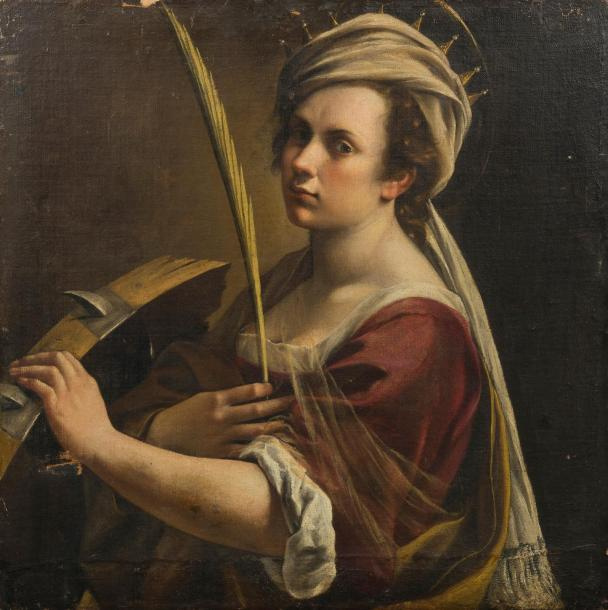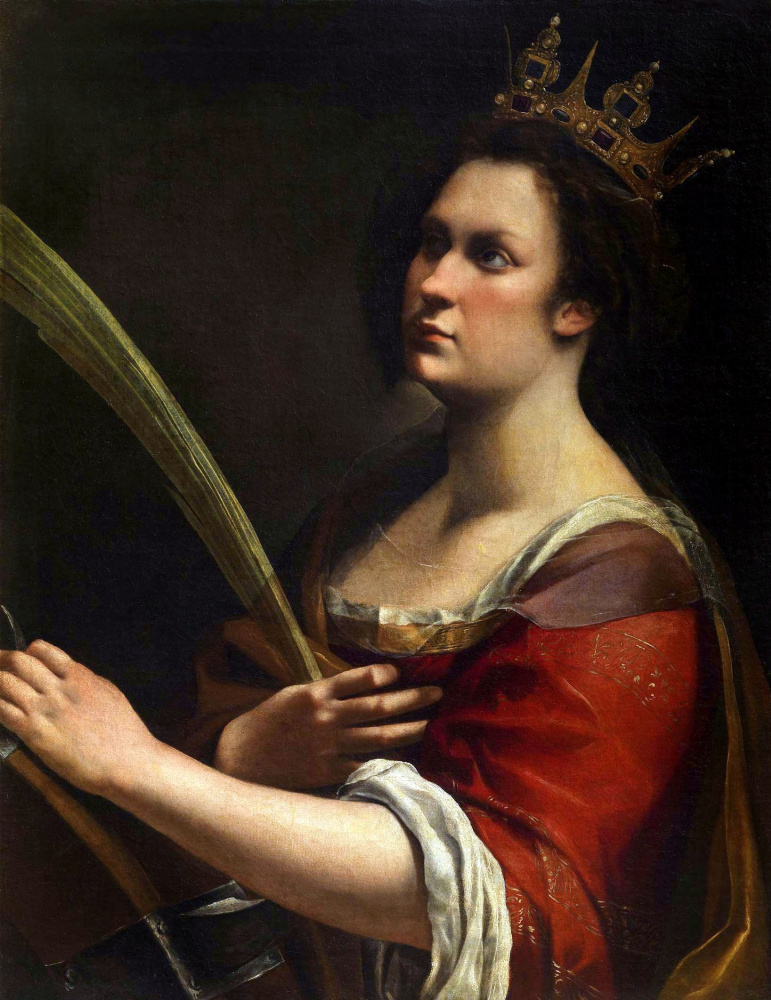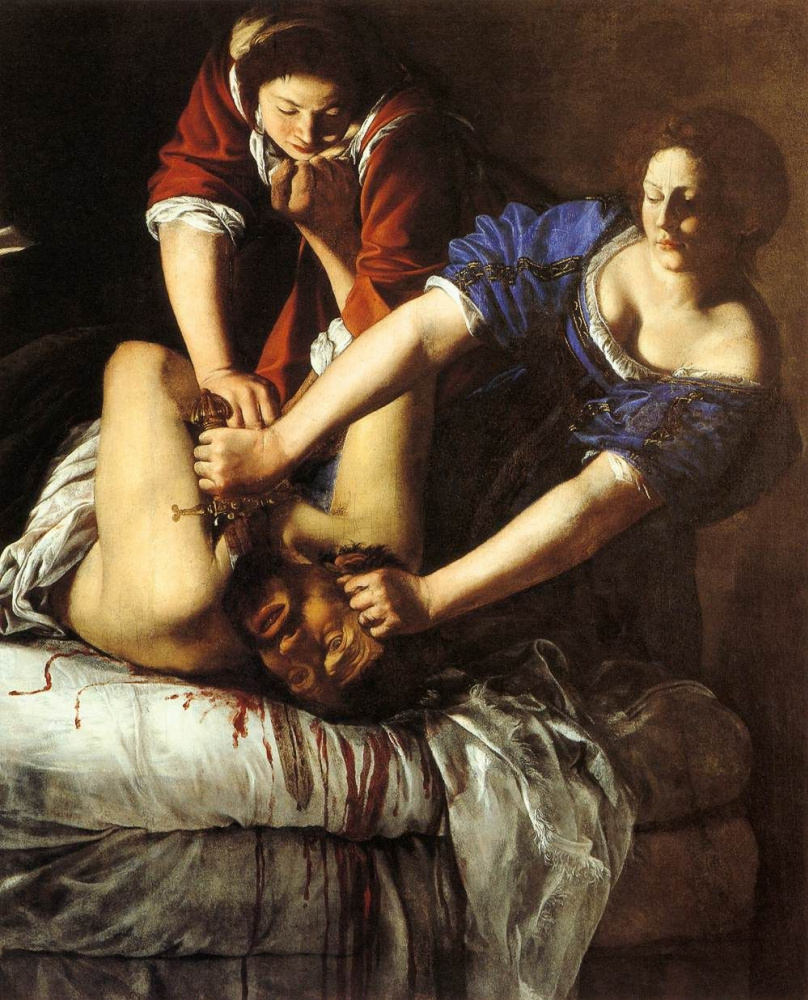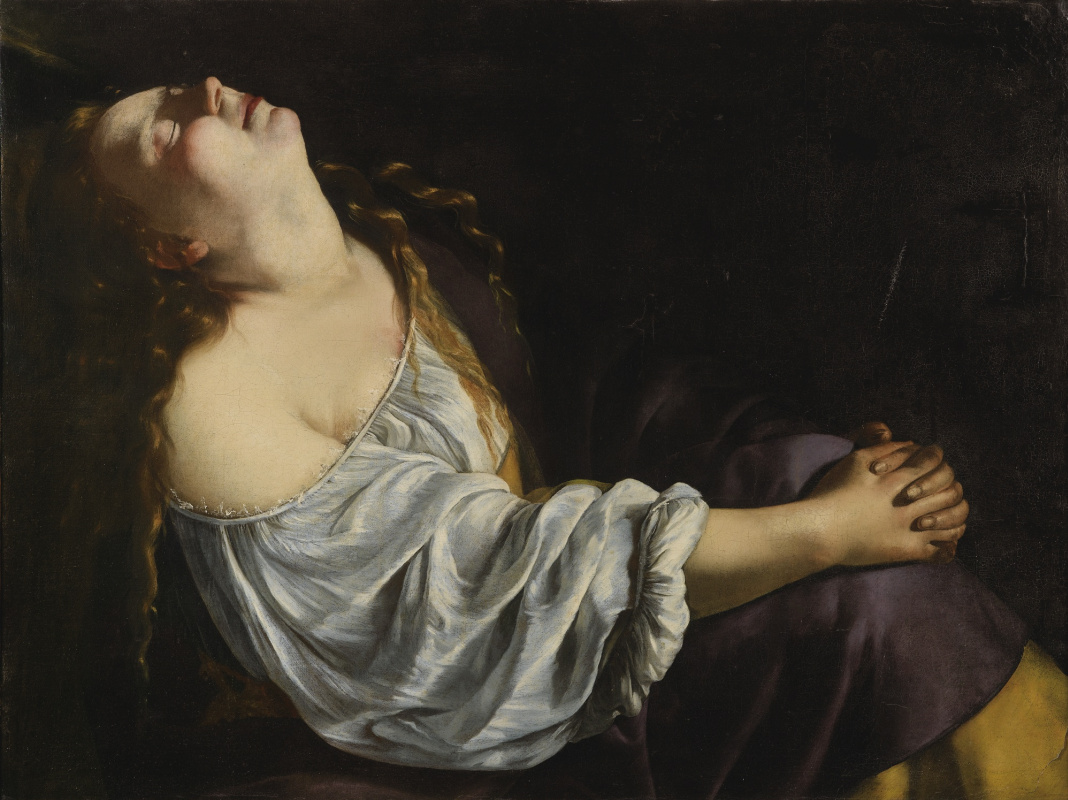A previously unknown self-portrait as Saint Catherine of Alexandria by Artemisia Gentileschi sold at Drouot auction in Paris on 19 December for an artist record €2,360,600.

Artemisia Gentileschi record sale
On Tuesday, December 19, 2017 the house Christophe Joron-Derem presented The Saint Catherine of Alexandria as previously unknown self-portrait of a famous Baroque female painter Artemisia Gentileschi (1593−1653), one of the first recognized women artists of her time and in the history of art. Against estimated of €300 000/400 000, the portrait fetched an artist record of €2,360,600 (€1.850m at the hammer) in a prestigious sale of old and modern paintings, furniture and objets of arts.Resemblance to St. Catherine from the Uffizi Gallery
According to auctioneers of Christophe Joron-Derem, the painting must be related to St. Catherine exhibited in the Uffizi Gallery in Florence dated around 1614−1616. It is part of the Florentine period of the artist while her paintings were still marked by the influence of her father Orazio Gentileschi (1563−1639) — Italian Baroque painter, the most innovative follower of Caravaggio.
Saint Catherine of Alexandria
1616, 77×62 cm
Artemisia affair
Artemisia Gentileschi is as famous for being the first female artist of her time as for the "Artemisia affair." She was raped by her father’s fellow-artist, the Florentine painter, Agostino Tassi when she was 18 years old. Promising to soon marry her, he continued to demand her sexual favors for several months but always avoided following through with the actual marriage.Once Orazio Gentileschi found out what was happening, he filed suit against Tassi. Agostino was arrested for rape, and a long seven-month-long trial has began. Its transcripts are still available today and they give us an insight into the trial pattern familiar even today: Artemisia was tortured to prove her honesty. She was accused of not having been a virgin at the time of the rape and of having many lovers, and she was examined by midwives to determine whether she had been "deflowered" recently or a long time ago.
Even though Artemisia has passed through so much humiliation and insults, she won. Tassi was ultimately convicted on the charge of raping Gentileschi and served under a year in prison.
Pregnant Artemisia was married off one month after the trial to a family friend, Peter Antonio Stiattesi, but left him within a few years.
Judith beheading Holofernes
1612, 199×162.6 cm
Traumatic experience as a source of inspiration
The traumatic experience of her youth provided the source for her artistic inspiration. Artemisia painted dozens of canvases encoding the harassing emotional experience into allegorical and religious images. Haunted by the ghost of the abuser, she made several versions of Judith beheading Holofernes, rendering her own features to Judith and depicting Agostino Tassi as Holofernes. She painted first composition of the scene at the end of the trial, clearly expressing her rage and violation.Rape became the major theme in her painting. She uses religious scenes to tell her story in many different ways: Judith and her maid, Susanna and the Elders (bellow left), Lucretia, Bathing Bathsheba (bellow right).
Proto-feminist artist
Artemisia Gentileschi is often seen as a porto-feminist artist. She was a very talented painter who managed to get through social neglect and disdain and became the first woman among official members of the Academy of Design in Florence in 1616.She came up with a new type of heroines in her art practice: a believable woman, full of dignity, boldly risking her life for the sake of truth, fellow-citizens, or Christ.
Self-portrait as Saint Catherine of Alexandria
It was not a random choice for Artemisia Gentileschi to portray herself as Saint Catherine in any ways. Following the grand popularity during the medieval period as a saint of the Catholic Church, St. Catherine was a frequent subject in renaissance art. Undoubtedly, Artemisia paralleled her own life to the life story of the martyr saint. Both women were smart and devoted to their ideals. And both of them possessed the charisma and courage to defend their beliefs.Christian tradition says Catherine of Alexandria was of noble birth. She was also educated and an avid scholar. To defend her brothers and sisters in Christ against persecutions, she denounced the Emperor Maximinus of his cruelty to his face and won religious debates with 50 orators and philosophers afterwards. Despite the following torture in prison, she did not abandon her faith but converted hundreds of people around her who unfortunately were immediately executed.
Even the final attempt of the Roman Emperor Maximinus to persuade the beautiful Catherine by proposing marriage to her, failed. Catherine refused, saying she was married to Jesus Christ and that her virginity was dedicated to him. The emperor angrily ordered her to be executed on a breaking wheel, which was an ancient form of torture. The brutal punishment made person’s limbs to thread among the spokes while the bones were shattered by an executioner with a heavy rod. A slow and painful death normally was reserved for the worst criminals. When Catherine was presented before the wheel, she touched it, and the instrument of torture was miraculously destroyed. The emperor, enraged beyond control, then had her beheaded.
The breaking wheel has been called the Catherine wheel in time. We see it on Artemisia’s portrait.
Marie Madeleine in Ecstasy
1610-th
, 81×105 cm
Worldwide recognition
For a long time Artemisia Gentileschi was regarded by many as a curiosity. Since the 1970s, she was considered as an icon of feminist empowerment and artistic accomplishment. A recent mini-survey of painting at the Museo di Roma has placed her among other prominent painters of the Baroque era. Now she is acclaimed as a second only to that of Caravaggio among 17th-century Italian artists.Self-Portrait as Saint Catherine is the finest of several recently rediscovered paintings by Gentileschi, including Magdalen in Ecstasy (above), which was also found in France and sold at Sotheby’s Paris in 2014 for $1,179,832, the artist’s previous record.
Feministic struggle for equal rights and privileges played not the least role in re-evaluation of Artemisia’s input into the treasure trove of cultural assets for all people. And the Weinstein file, which is on everyone’s lips now, has obviously piqued the curiosity about the female artist as another woman who resisted. However, art historians are a bit confused that her international recognition brings good commissions to auction houses but she is still not represented in any important museums: neither at the National Galleries in London or Washington, DC, nor at the Getty, nor at the Louvre. Well, hope never dies, and some major museum would be astute enough to acquire Artemisia Gentileschi one day.
Written on materials of drouot.com, joron-derem.com, theartnewspaper.com, blouinartinfo.com, arthistoryarchive.com, catholic.org. Title illustration: Artemisia Gentileschi, Self-Portrait as Saint Catherine of Alexandria, oil on canvas, 1614−16, private collection. Video: courtesy of joron-derem.com.



















